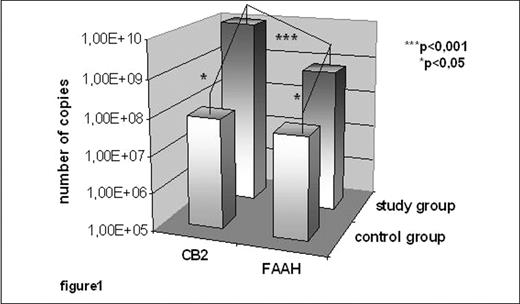Abstract
Background:
Chronic lymphocytic leukaemia (CLL) is one of the diseases in which processes of proliferation and apoptosis are seriously altered. Endocannabinoid system can modulate these processes. Cannabinoid receptor CB2 mainly expressed on lymphocytes and fatty acid amine hydrolase (FAAH) constitute a part of endocannabinoid system responsible respectively for interaction and degradation of cannabinoids. Both the receptor and enzyme are membrane proteins that can influence the lymphocyte fate. It has recently been suggested that this system may be a new potential target of anticancer therapy.
Aims:
The aim of our study was the assessment of receptor CB2 and FAAH mRNA expression in the lymphocytes B derived from patients with newly diagnosed chronic lymphocytic leukaemia.
Material and methods:
We assessed 15 peripheral blood samples from the CLL patients and 5 samples from healthy donors as a control group. The expression of CB2 receptor and FAAH proteins were measured indirectly by determination of their specific mRNA. The isolation of mononuclear cells from peripheral blood was carried out with the use of density centrifugation method. The resolution of mononuclear cell population to lymphocytes B subpopulation was done with negative isolation method utilising magnetic microballs. Total RNA was isolated from B-lymphatic cells of which 10ng was used in each reaction. RT-PCR was carried out with the use of Light Cycler (Roche) and respective commercial kits. The nucleotides sequence and parameters of the amplification process were based on method previously described by Matias et al (2002).
Results:
We found significantly higher mRNA levels of CB2 receptor in the study group in comparison to the control group. The levels of FAAH mRNA were also higher in the study group in comparison to the controls. Furthermore the number of mRNA copies was higher in case of CB2 receptor than FAAH in the CLL patients. Those numbers were comparable in the healthy controls. The results are presented as a mean number of copies in figure below.
Conclusions:
The results of our study show that during the leukaemic transformation there might be an alteration in the expression of some constituents of the endocannabinoid system. Those findings suggest the potential role of the endocannabinoid system in the neoplastic processes. Thus the assessment of the CB2 and FAAH mRNA might help to understand the biological reactions underlying the complex etiology of neoplastic disorders. Furthermore the explanation of all aspects of the role of endocannabinoid system in lymphoid malignancies should help to make it a new target of antileukaemic treatment.
Author notes
Corresponding author


This feature is available to Subscribers Only
Sign In or Create an Account Close Modal